Interest rates were remarkably calm in the last week of March. The market was in the process of shifting focus from the banking sector back to economic data. It just so happened that last week was light on data. This week was quite the opposite.
The first week of any given month often brings several of the most meaningful monthly economic releases. These include reports from the Institute for Supply Management (ISM) and most notably, the Employment Situation (more commonly referred to as “the jobs report”).
Virtually all of the economic data that came out in the first 3 days of the week was good for bonds/rates. In other words, the data was weaker than expected. Bonds benefit from weak data because a slower economy is less capable of sustaining growth and inflation–two of the main pillars of interest rates.
As expected, bonds were eager to get some actionable economic updates and rates wasted no time responding to downbeat news from ISM. There are two flavors of ISM Purchasing Managers Indices (PMIs). Each can be thought of as a broad barometer for growth in the corresponding sector where anything over 50 is good/growing and anything under 50 signals contraction.

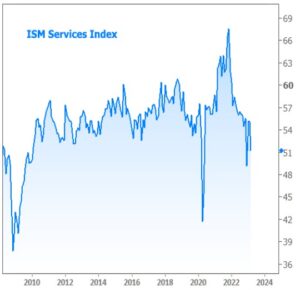
Rounding out the rate-friendly news in the first half of the week, the Job Openings and Labor Turnover Survey (JOLTS) showed much lower job openings in the month of February. The numbers are still very high overall, but markets are looking for a trend as opposed to an outright level. Taken in conjunction with the ISM data, JOLTS added to the sense that persistently resilient economic momentum is cooling off.
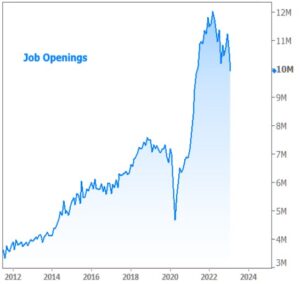
But JOLTS wasn’t the market’s first choice of labor market indicators for the week. The big jobs report is in a different league. In this case, it actually had something different to say. Job creation was right in line with expectations. Wage growth stayed solid. Unemployment ticked down to 3.5%, and the labor force grew to its largest level since March 2020. It would be hard to make a strong case for labor market weakness when a chart of the unemployment rate looks like this:

The bond market agreed and quickly re-thought some of the progress it had made in the wake of the week’s previous data. To be fair, traders already thought plenty of progress had been made by Wednesday morning based on the way momentum toward lower rates dried up by the middle of Wednesday.
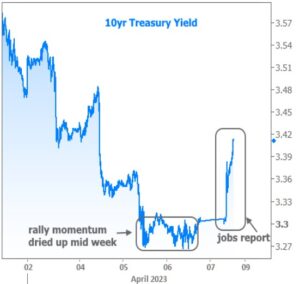
The reversal was even more pronounced for Fed rate hike expectations. At one point, the market had completely priced out the chance that the Fed would hike rates again this year. But after the jobs report, rate expectations returned to the same levels from the start of the week.
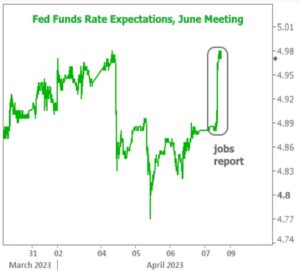
Mortgage rates almost always follow the rest of the bond market, even though the proportions can vary. The average lender made it down to the lowest 30yr fixed rates since early February by Thursday, but then bounced higher with the rest of the bond market on Friday. On a bright note, the bounce in mortgage rates wasn’t nearly as big as it was for other parts of the bond market.
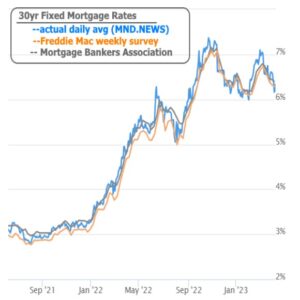
In the bigger picture, top tier rates have been consolidating in a range between 6 and 7 percent, roughly. This is emblematic of the broader debate for the entire bond market. Whether it’s 6-7% in mortgages or 3.3-3.8% in 10yr Treasury yields, markets are waiting for clarity on growth and inflation. If this week’s data was only worth a small amount of volatility in that broader range, it’s not hard to imagine that we’ll need a few months of consistent messaging from other economic data to settle the debate.
Still, some voices are louder than others when it comes to this particular debate and we’ll hear from one of the loudest next week. The Consumer Price Index (CPI) will be released on Wednesday morning. If there is one other report with as much street cred as the big jobs report these days, CPI is it. If it shows core inflation coming in hotter than expected for March, rates would be under pressure to head back up into the prevailing range. But if inflation looks like it’s shifting into a calmer gear, rates might not need much more convincing before attempting to break below that range.
Subscribe to my newsletter online at: http://mortgageratesupdate.com/acelandmortgage
